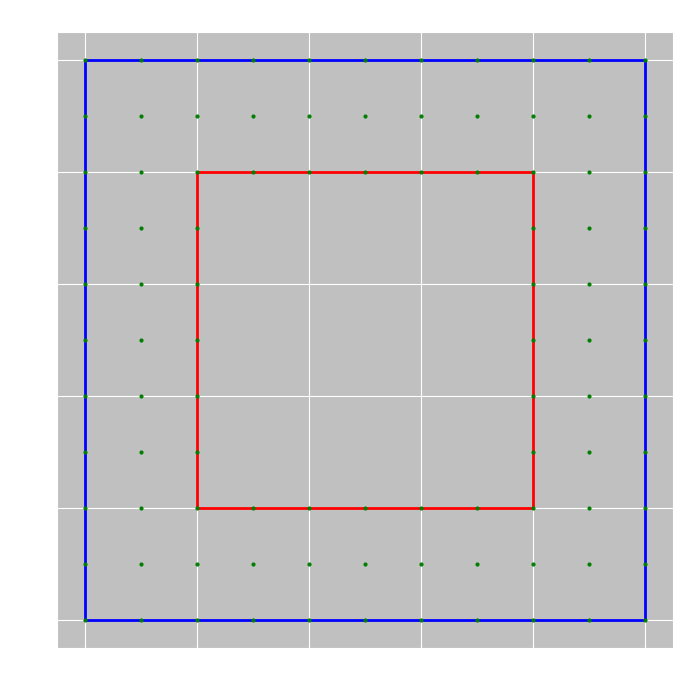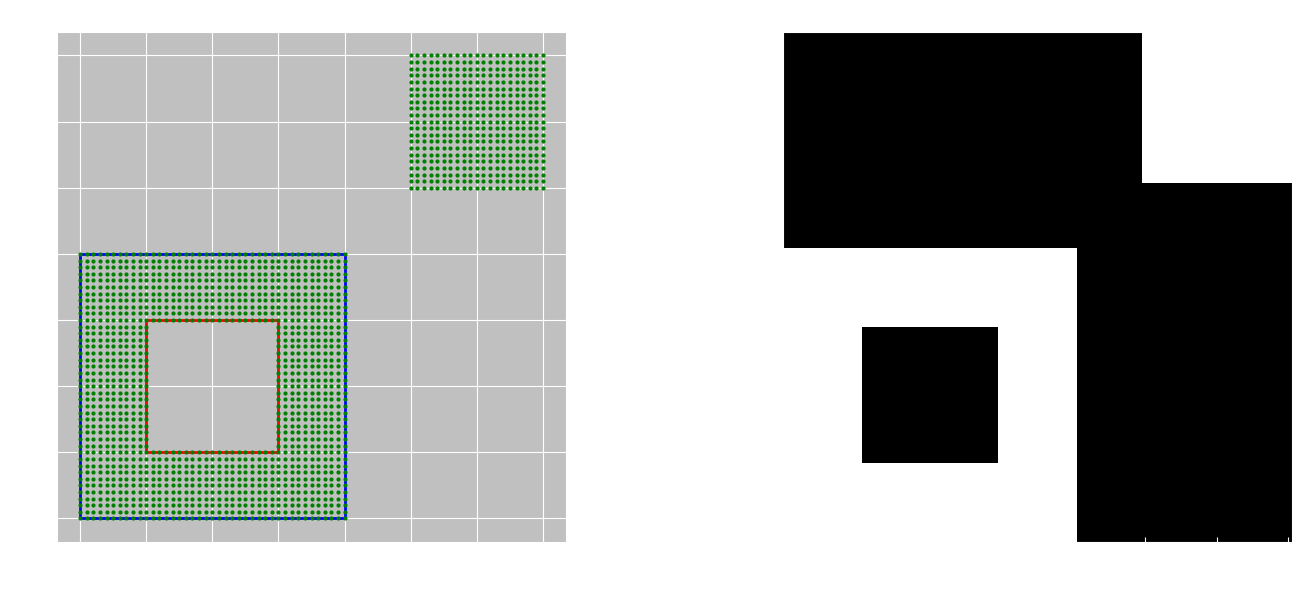shepely

简单示例
from shapely.geometry import Polygon
# 创建一个多边形
polygon = Polygon([(0, 0), (0, 5), (5, 5), (5, 0)])
# 提取多边形中的点
points = list(polygon.exterior.coords)
# 打印结果
print(points)
实际示例
import numpy as np
from shapely.geometry import Polygon, Point, MultiPolygon
import matplotlib.pyplot as plt
from matplotlib.path import Path
plt.rcParams['figure.facecolor'] = 'white'
plt.rcParams['axes.facecolor'] = 'silver'
# 网格线
plt.rcParams['xtick.direction'] = 'in'
print(plt.rcParams["font.sans-serif"])
# 设置全局字体为黑体
# plt.rcParams['font.sans-serif'] = ['simhei'] # 替换为其他中文字体如
def get_integer_points_in_polygon(polygon, include_boundary=True):
"""
获取多边形内部的所有整数坐标点
参数:
polygon: Shapely Polygon对象(可以包含孔洞)
include_boundary: 是否包含边界上的点
返回:
list: 多边形内部的整数坐标点列表 [(x1, y1), (x2, y2), ...]
"""
# 获取多边形的边界框
min_x, min_y, max_x, max_y = polygon.bounds
# 将边界框坐标转换为整数
min_x, min_y, max_x, max_y = map(int, [min_x, min_y, max_x, max_y])
# 生成边界框内的所有整数点
x_coords = np.arange(min_x, max_x + 1)
y_coords = np.arange(min_y, max_y + 1)
# 创建网格点
xx, yy = np.meshgrid(x_coords, y_coords)
grid_points = np.vstack((xx.flatten(), yy.flatten())).T
# 检查每个点是否在多边形内部
interior_points = []
for point in grid_points:
shapely_point = Point(point)
if polygon.contains(shapely_point) or (include_boundary and polygon.touches(shapely_point)):
interior_points.append(tuple(point))
return interior_points
def visualize_polygon_and_points(polygon, points):
"""
可视化多边形和内部点
参数:
polygon: Shapely Polygon对象
points: 点列表
"""
fig, ax = plt.subplots(figsize=(10, 8), facecolor='white')
# 绘制多边形
if hasattr(polygon, 'exterior'):
# 单个多边形
x, y = polygon.exterior.xy
ax.plot(x, y, 'b-', linewidth=2)
# 绘制孔洞
for interior in polygon.interiors:
x, y = interior.xy
ax.plot(x, y, 'r-', linewidth=2)
else:
# 多多边形
for poly in polygon.geoms:
x, y = poly.exterior.xy
ax.plot(x, y, 'b-', linewidth=2)
for interior in poly.interiors:
x, y = interior.xy
ax.plot(x, y, 'r-', linewidth=2)
# 绘制点
if points:
x_pts, y_pts = zip(*points)
ax.plot(x_pts, y_pts, 'go', markersize=2)
ax.set_aspect('equal')
plt.title('多边形及其内部整数点')
plt.xlabel('X坐标')
plt.ylabel('Y坐标')
plt.grid(True)
plt.show()
# 使用示例
if __name__ == "__main__":
# 创建一个带孔洞的多边形示例
exterior = [(0, 0), (10, 0), (10, 10), (0, 10), (0, 0)]
interior = [(2, 2), (8, 2), (8, 8), (2, 8), (2, 2)]
polygon = Polygon(exterior, [interior])
# 获取多边形内部的所有整数点
points = get_integer_points_in_polygon(polygon)
print(f"找到 {len(points)} 个内部整数点")
print("前10个点:", points[:10])
# 可视化
visualize_polygon_and_points(polygon, points)
geopandas

处理非标准geojson
import json
import geopandas as gpd
import pandas as pd
from shapely.geometry import Polygon, GeometryCollection
import matplotlib.pyplot as plt
# 方法1:直接解析GeometryCollection
def parse_geometry_collection(geojson_data):
"""解析GeometryCollection格式的GeoJSON"""
features = []
if geojson_data.get('type') != 'GeometryCollection':
raise ValueError("不是GeometryCollection格式")
for geom in geojson_data.get('geometries', []):
# 提取几何类型和坐标
geom_type = geom.get('type')
coords = geom.get('coordinates', [])
# 提取属性
properties = geom.get('properties', {})
# 创建对应的shapely几何对象
if geom_type == 'Polygon':
geometry = Polygon(coords[0]) # 多边形外环
elif geom_type == 'Point':
from shapely.geometry import Point
geometry = Point(coords)
elif geom_type == 'LineString':
from shapely.geometry import LineString
geometry = LineString(coords)
else:
continue # 跳过不支持的几何类型
features.append({
'type': 'Feature',
'geometry': geometry,
'properties': properties
})
print(features)
return features
# 方法2:转换为标准GeoJSON格式
def convert_to_standard_geojson(geojson_data):
"""将GeometryCollection转换为标准FeatureCollection格式"""
features = parse_geometry_collection(geojson_data)
return {
'type': 'FeatureCollection',
'features': features
}
# 方法3:创建GeoDataFrame
def create_geodataframe(geojson_data):
"""从GeometryCollection创建GeoDataFrame"""
features = parse_geometry_collection(geojson_data)
# 提取几何和属性
geometries = [f['geometry'] for f in features]
properties = [f['properties'] for f in features]
# 创建GeoDataFrame
gdf = gpd.GeoDataFrame(properties, geometry=geometries)
return gdf
# 使用示例
if __name__ == "__main__":
# 示例数据(根据您提供的格式)
geojson_data = {
"type": "GeometryCollection",
"geometries": [
{
"type": "Polygon",
"properties": {"uID": 0, "label": "1"},
"coordinates": [[[10436, 6198], [10481, 6198], [10504, 6221], [10436, 6198]]]
},
{
"type": "Polygon",
"properties": {"uID": 1, "label": "2"},
"coordinates": [[[10550, 6250], [10600, 6250], [10600, 6300], [10550, 6300], [10550, 6250]]]
}
]
}
# 解析GeometryCollection
features = parse_geometry_collection(geojson_data)
print("解析出的要素数量:", len(features))
# 转换为标准GeoJSON
standard_geojson = convert_to_standard_geojson(geojson_data)
print("标准GeoJSON格式已创建")
# 创建GeoDataFrame
gdf = create_geodataframe(geojson_data)
print("GeoDataFrame信息:")
print(gdf.head())
# 可视化
fig, ax = plt.subplots(figsize=(10, 8), facecolor='white')
gdf.plot(ax=ax, color='lightblue', edgecolor='black')
# 添加标签
for idx, row in gdf.iterrows():
centroid = row.geometry.centroid
ax.text(centroid.x, centroid.y, row['label'],
fontsize=12, ha='center', va='center')
plt.title("GeometryCollection中的多边形")
plt.xlabel("X坐标")
plt.ylabel("Y坐标")
plt.grid(True)
plt.show()
# 保存为标准GeoJSON文件
gdf.to_file("converted.geojson", driver="GeoJSON")
print("已保存为标准GeoJSON文件: converted.geojson")
处理实际文件
import json
# 从文件读取GeometryCollection格式的GeoJSON
def read_geometry_collection_file(file_path):
"""从文件读取GeometryCollection格式的GeoJSON"""
with open(file_path, 'r') as f:
geojson_data = json.load(f)
return geojson_data
# 使用示例
file_path = "your_file.geojson" # 替换为实际文件路径
geojson_data = read_geometry_collection_file(file_path)
# 处理数据
gdf = create_geodataframe(geojson_data)
print(gdf.info())
确保多边形坐标闭合
def ensure_polygon_closed(coordinates):
"""确保多边形坐标闭合(首尾点相同)"""
if not coordinates:
return coordinates
# 对于多边形,coordinates是一个列表的列表
# 第一个列表是外环,后续列表是内环(孔)
closed_coords = []
for ring in coordinates:
if len(ring) < 3:
continue # 跳过无效环(至少需要3个点)
# 检查是否闭合(第一个点和最后一个点相同)
first_point = ring[0]
last_point = ring[-1]
if first_point != last_point:
# 添加第一个点作为最后一个点以闭合环
closed_ring = ring + [first_point]
else:
closed_ring = ring
closed_coords.append(closed_ring)
return closed_coords
提取坐标信息
def extract_coordinates_from_geometry_collection(geojson_data):
"""从GeometryCollection中提取所有坐标"""
coordinates = []
if geojson_data.get('type') != 'GeometryCollection':
return coordinates
for geom in geojson_data.get('geometries', []):
geom_type = geom.get('type')
coords = geom.get('coordinates', [])
properties = geom.get('properties', {})
if geom_type == 'Polygon':
# 多边形坐标 - 第一个列表是外环,后续列表是内环(孔)
for ring in coords:
coordinates.extend(ring)
elif geom_type == 'Point':
coordinates.append(coords)
elif geom_type == 'LineString':
coordinates.extend(coords)
elif geom_type == 'MultiPolygon':
for polygon in coords:
for ring in polygon:
coordinates.extend(ring)
return coordinates
# 使用示例
all_coords = extract_coordinates_from_geometry_collection(geojson_data)
print(f"提取到 {len(all_coords)} 个坐标点")
print("前10个坐标:", all_coords[:10])
生成mask

import numpy as np
from shapely.geometry import Polygon, MultiPolygon, Point
import matplotlib.pyplot as plt
from matplotlib.path import Path
import matplotlib.patches as patches
import json
def get_integer_points_from_geometry_collection(geojson_data):
"""
从GeometryCollection中提取所有多边形内部的整数坐标点
参数:
geojson_data: GeometryCollection格式的GeoJSON数据
返回:
set: 所有多边形内部的整数坐标点集合
"""
interior_points = set()
if geojson_data.get('type') != 'GeometryCollection':
return interior_points
for geom in geojson_data.get('geometries', []):
geom_type = geom.get('type')
coords = geom.get('coordinates', [])
properties = geom.get('properties', {})
if geom_type == 'Polygon':
# 创建Shapely多边形对象
polygon = Polygon(coords[0], coords[1:])
# 获取多边形内部的整数点
points = get_integer_points_in_polygon(polygon)
interior_points.update(points)
elif geom_type == 'MultiPolygon':
# 处理多多边形
for polygon_coords in coords:
polygon = Polygon(polygon_coords[0], polygon_coords[1:])
points = get_integer_points_in_polygon(polygon)
interior_points.update(points)
return interior_points
def get_integer_points_in_polygon(polygon):
"""
获取多边形内部的所有整数坐标点
参数:
polygon: Shapely Polygon对象
返回:
set: 多边形内部的整数坐标点集合
"""
# 获取多边形的边界框
min_x, min_y, max_x, max_y = polygon.bounds
# 将边界框坐标转换为整数
min_x, min_y, max_x, max_y = map(int, [np.floor(min_x), np.floor(min_y),
np.ceil(max_x), np.ceil(max_y)])
# 生成边界框内的所有整数点
x_coords = np.arange(min_x, max_x + 1)
y_coords = np.arange(min_y, max_y + 1)
# 创建网格点
xx, yy = np.meshgrid(x_coords, y_coords)
grid_points = np.vstack((xx.flatten(), yy.flatten())).T
# 检查每个点是否在多边形内部
include_boundary = True
interior_points = []
for point in grid_points:
shapely_point = Point(point)
if polygon.contains(shapely_point) or (include_boundary and polygon.touches(shapely_point)):
interior_points.append(tuple(point))
return interior_points
# # 修正后的路径创建方法 - 确保代码数组是一维且长度匹配
# exterior = np.array(polygon.exterior.coords)
# # 创建路径代码 - 确保是一维数组
# n_points = len(exterior)
# codes = np.ones(n_points, dtype=Path.code_type) * Path.LINETO
# codes[0] = Path.MOVETO
# # 创建路径
# path = Path(exterior, codes)
# # 检查每个点是否在多边形内部
# contains = path.contains_points(grid_points)
# interior_points = set(tuple(map(int, point)) for point, inside in zip(grid_points, contains) if inside)
# return interior_points
def create_mask_from_points(points, shape=None):
"""
从点集合创建二值mask
参数:
points: 点集合
shape: mask的形状 (height, width)。如果为None,则根据点坐标自动确定
返回:
numpy.array: 二值mask
"""
if not points:
return np.array([]), (0, 0)
# 如果没有指定形状,则根据点坐标确定
if shape is None:
all_x = [p[0] for p in points]
all_y = [p[1] for p in points]
min_x, max_x = min(all_x), max(all_x)
min_y, max_y = min(all_y), max(all_y)
width = max_x - min_x + 1
height = max_y - min_y + 1
origin = (min_x, min_y)
else:
height, width = shape
origin = (0, 0)
# 创建空的mask
mask = np.zeros((height, width), dtype=np.uint8)
# 填充mask
for point in points:
x, y = point
mask_y = y - origin[1]
mask_x = x - origin[0]
if 0 <= mask_y < height and 0 <= mask_x < width:
mask[mask_y, mask_x] = 1
return mask, origin
def visualize_polygon_and_mask(polygon, mask, origin, points=None):
"""
可视化多边形和mask
参数:
polygon: Shapely Polygon对象
mask: 二值mask
origin: mask的原点坐标
points: 点集合(可选)
"""
fig, (ax1, ax2) = plt.subplots(1, 2, figsize=(15, 6))
# 绘制多边形
if hasattr(polygon, 'exterior'):
# 单个多边形
x, y = polygon.exterior.xy
ax1.plot(x, y, 'b-', linewidth=2)
# 绘制孔洞
for interior in polygon.interiors:
x, y = interior.xy
ax1.plot(x, y, 'r-', linewidth=2)
else:
# 多多边形
for poly in polygon.geoms:
x, y = poly.exterior.xy
ax1.plot(x, y, 'b-', linewidth=2)
for interior in poly.interiors:
x, y = interior.xy
ax1.plot(x, y, 'r-', linewidth=2)
# 绘制点
if points:
x_pts, y_pts = zip(*points)
ax1.plot(x_pts, y_pts, 'go', markersize=2)
ax1.set_aspect('equal')
ax1.set_title('多边形及其内部整数点')
ax1.set_xlabel('X坐标')
ax1.set_ylabel('Y坐标')
ax1.grid(True)
# 绘制mask
ax2.imshow(mask, cmap='gray', origin='lower')
ax2.set_title('生成的Mask')
ax2.set_xlabel(f'X (原点: {origin[0]})')
ax2.set_ylabel(f'Y (原点: {origin[1]})')
plt.tight_layout()
plt.show()
def process_geojson_data(geojson_data):
"""
处理GeoJSON数据并生成mask
参数:
geojson_data: GeoJSON数据
返回:
mask: 二值mask
origin: mask的原点坐标
interior_points: 内部点集合
"""
# 提取多边形内部的所有整数点
interior_points = get_integer_points_from_geometry_collection(geojson_data)
print(f"找到 {len(interior_points)} 个内部整数点")
# 创建mask
mask, origin = create_mask_from_points(interior_points)
print(f"Mask形状: {mask.shape}, 原点: {origin}")
# 可视化
# 注意:这里简化处理,只可视化第一个多边形
if geojson_data.get('type') == 'GeometryCollection' and geojson_data.get('geometries'):
first_geom = geojson_data['geometries'][0]
if first_geom.get('type') == 'Polygon':
polygon = Polygon(first_geom['coordinates'][0], first_geom['coordinates'][1:])
visualize_polygon_and_mask(polygon, mask, origin, interior_points)
return mask, origin, interior_points
# 使用示例
if __name__ == "__main__":
# 示例GeometryCollection数据
geojson_data = {
"type": "GeometryCollection",
"geometries": [
{
"type": "Polygon",
"properties": {"uID": 0, "label": "1"},
"coordinates": [
[[10, 10], [50, 10], [50, 50], [10, 50], [10, 10]], # 外环
[[20, 20], [40, 20], [40, 40], [20, 40], [20, 20]] # 内环(孔洞)
]
},
{
"type": "Polygon",
"properties": {"uID": 1, "label": "2"},
"coordinates": [
[[60, 60], [80, 60], [80, 80], [60, 80], [60, 60]]
]
}
]
}
# 处理数据
mask, origin, interior_points = process_geojson_data(geojson_data)
# 保存mask为图像
plt.imsave('mask.png', mask, cmap='gray')
print("Mask已保存为 mask.png")
# 保存点坐标到文件
with open('interior_points.txt', 'w') as f:
for point in sorted(interior_points):
f.write(f"{point[0]}, {point[1]}\n")
print("点坐标已保存为 interior_points.txt")